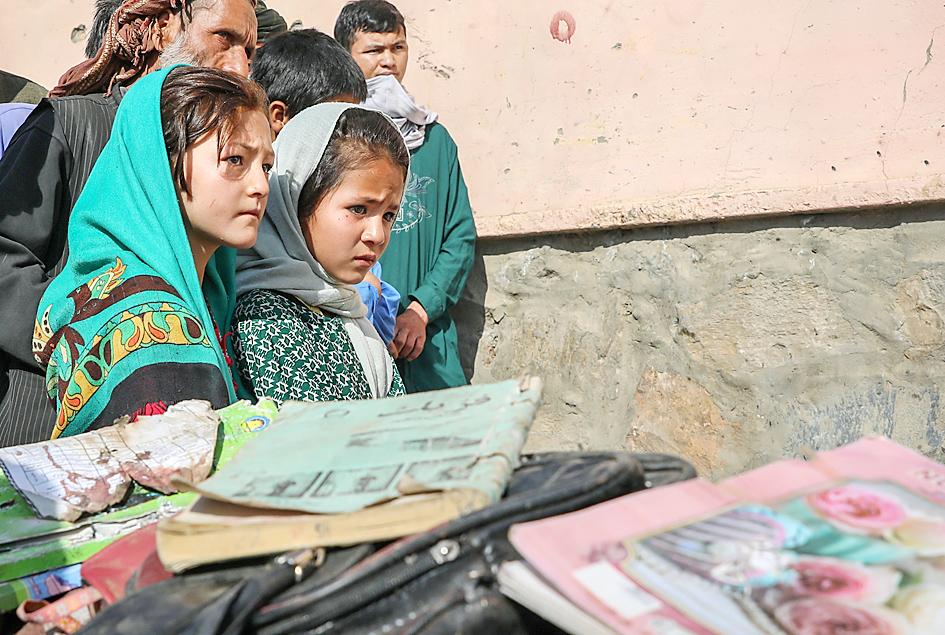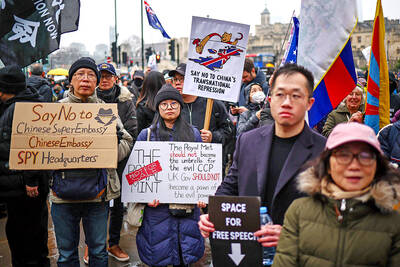The death toll in a horrific bombing at a girls’ school in the Afghan capital has soared to 50, many of them pupils aged 11 to 15, the Interior Ministry said yesterday.
The number of wounded in Saturday’s attack has also climbed to more than 100, Afghan Ministry of Interior Affairs spokesman Tariq Arian said.
Three explosions outside the school entrance struck as students were leaving for the day, he said.

Photo: EPA-EFE
The blasts occurred in a mostly Shiite neighborhood in the west of the capital. The Taliban denied responsibility, condemning the attack.
The first explosion came from a vehicle packed with explosives, followed by two others, Arian said, adding that the casualty figures could still rise.
In the capital, rattled by relentless bombings, Saturday’s attack was among the worst. Criticism has mounted over lack of security and growing fears of even more violence as the US and NATO complete their final military withdrawal from Afghanistan.
The attack targeted Afghanistan’s ethnic Hazaras who dominate the western Dasht-e-Barchi neighborhood, where the bombings occurred. Most Hazaras are Shiite Muslims.
The area has been hit by violence against minority Shiites and most often claimed by an Islamic State affiliate operating in the country. No one has yet claimed Saturday’s bombings.
The radical Sunni Muslim group has declared war on Afghanistan’s Shiites. Washington blamed Islamic State for a vicious attack last year in a maternity hospital in the same area that killed pregnant women and newborn babies.
Soon after the bombing, angry crowds attacked ambulances and even beat health workers as they tried to evacuate the wounded, Afghan Ministry of Public Health spokesman Ghulam Dastigar Nazari said, urging residents to cooperate and allow ambulances free access to the site.
Bloodied backpacks and schools books lay strewn outside the Syed Al-Shahda school. In the morning, boys attend classes in the sprawling school compound and in the afternoon, it is the girls’ turn.
Residents in the area said the explosion was deafening. Naser Rahimi said he heard three separate explosions, and immediately thought that the sheer power of the blasts meant the death toll would almost certainly climb.
One of the students fleeing the school recalled the attack, the girls’ screams of the girls, the blood.
“I was with my classmate, we were leaving the school, when suddenly an explosion happened,” said 15-year-old Zahra, whose arm had been broken by a piece of shrapnel.
“Ten minutes later there was another explosion and just a couple of minutes later another explosion,” she said. “Everyone was yelling and there was blood everywhere, and I couldn’t see anything clearly.”
Her friend died.
Outside the Muhammad Ali Jinnah Hospital, in the Dasht-e-Barchi neighborhood dozens of people lined up to donate blood, while family members checked casualty posted lists on the walls.
Most of the dozens of injured brought to the Emergency Hospital for war wounded in Kabul, “almost all girls and young women between 12 and 20 years old,” said Marco Puntin, the hospital’s program coordinator in Afghanistan.
In a statement following the attack, the hospital said the first three months of this year has seen a 21 percent increase in war-wounded.
The Islamic State has previously claimed attacks against minority Shiites in the same area, last year claiming two brutal attacks on education facilities that killed 50 people, most of them students.
Even as the Islamic State has been degraded in Afghanistan, according to government and US officials, it has stepped up its attacks particularly against Shiite Muslims and women workers.
Earlier the group took responsibility for the targeted killing of three women media personnel in eastern Afghanistan.

Thousands gathered across New Zealand yesterday to celebrate the signing of the country’s founding document and some called for an end to government policies that critics say erode the rights promised to the indigenous Maori population. As the sun rose on the dawn service at Waitangi where the Treaty of Waitangi was first signed between the British Crown and Maori chiefs in 1840, some community leaders called on the government to honor promises made 185 years ago. The call was repeated at peaceful rallies that drew several hundred people later in the day. “This government is attacking tangata whenua [indigenous people] on all

RIGHTS FEARS: A protester said Beijing would use the embassy to catch and send Hong Kongers to China, while a lawmaker said Chinese agents had threatened Britons Hundreds of demonstrators on Saturday protested at a site earmarked for Beijing’s controversial new embassy in London over human rights and security concerns. The new embassy — if approved by the British government — would be the “biggest Chinese embassy in Europe,” one lawmaker said earlier. Protester Iona Boswell, a 40-year-old social worker, said there was “no need for a mega embassy here” and that she believed it would be used to facilitate the “harassment of dissidents.” China has for several years been trying to relocate its embassy, currently in the British capital’s upmarket Marylebone district, to the sprawling historic site in the

‘IMPOSSIBLE’: The authors of the study, which was published in an environment journal, said that the findings appeared grim, but that honesty is necessary for change Holding long-term global warming to 2°C — the fallback target of the Paris climate accord — is now “impossible,” according to a new analysis published by leading scientists. Led by renowned climatologist James Hansen, the paper appears in the journal Environment: Science and Policy for Sustainable Development and concludes that Earth’s climate is more sensitive to rising greenhouse gas emissions than previously thought. Compounding the crisis, Hansen and colleagues argued, is a recent decline in sunlight-blocking aerosol pollution from the shipping industry, which had been mitigating some of the warming. An ambitious climate change scenario outlined by the UN’s climate

A deluge of disinformation about a virus called hMPV is stoking anti-China sentiment across Asia and spurring unfounded concerns of renewed lockdowns, despite experts dismissing comparisons with the COVID-19 pandemic five years ago. Agence France-Presse’s fact-checkers have debunked a slew of social media posts about the usually non-fatal respiratory disease human metapneumovirus after cases rose in China. Many of these posts claimed that people were dying and that a national emergency had been declared. Garnering tens of thousands of views, some posts recycled old footage from China’s draconian lockdowns during the COVID-19 pandemic, which originated in the country in late